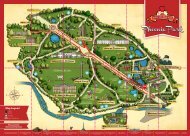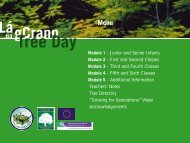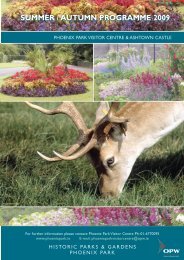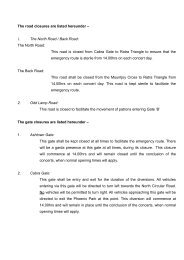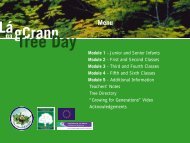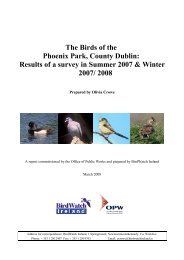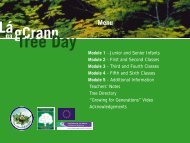Phoenix Park Conservation Management Plan Appendices
Phoenix Park Conservation Management Plan Appendices
Phoenix Park Conservation Management Plan Appendices
You also want an ePaper? Increase the reach of your titles
YUMPU automatically turns print PDFs into web optimized ePapers that Google loves.
US Ambassador’s Residence (Deerfield) Historically known as the Chief Secretary’s Demesne<br />
Area Name Current use and facilities Historical name and use Description<br />
Residence U.S. Ambassador’s Residence. Formally the location of the <strong>Park</strong> bailiff’s<br />
residence. The present house was built in<br />
1776 by Sir John Blaquiere, chief secretary to<br />
the Lord Lieutenant. It became the residence<br />
of the Chief Secretary to the Viceroy in<br />
1782 and residence to the U.S. Ambassador<br />
in 1927.<br />
High intensity of use as residence with high levels of security. Private space for the Ambassador and family which includes parkland, pleasure<br />
grounds, walled gardens, and agricultural areas and farmyard. There are also a number of relatively modern single storey dwellings.<br />
Main Entrance Gate and Lodges (Guardhouses)<br />
Used as security facility. Attributed to Jacob Owen circa 1845. Main<br />
entrance to the demesne and residence.<br />
Triple arch entrance gate with accompanying lodges (guardhouses) replaces a former gateway at this location. The highly ornate gates are by the<br />
famous iron founder Richard Turner.<br />
Pleasure Grounds Large extensively planted ornamental area on<br />
the south side of the residence.<br />
Previously used as pleasure grounds.<br />
A series of walled enclosures with manicured<br />
lawns, orchard trees, rose beds and<br />
herbaceous borders in low intensity private<br />
use. Each walled enclosure is laid out in a<br />
different form. The main drive terminates<br />
at the main entrance to the house. A small<br />
hard paved car park is provided in one of the<br />
smaller walled enclosures. The regime of<br />
grounds management has given the gardens a<br />
North American character.<br />
Victorian style pleasure grounds with an uninterrupted view into the <strong>Phoenix</strong> <strong>Park</strong> and Dublin Mountains. (The entire demesne is surrounded by a<br />
sunken fence primarily dating from the 1840s). Grounds contain a number of ceremonial trees dating from the Victorian period to the present day.<br />
Yards and domestic buildings Serving as stores and accommodation for use<br />
by the ambassador and his staff.<br />
Stables, servants accommodation and<br />
gardeners house. Formerly used as farmyard<br />
buildings and stores.<br />
Currently used as store yard for machinery and other equipment. A small walled enclosed area (Haggard) which contains fruit trees is located nearby.<br />
<strong>Park</strong>land (east of house) Grazed and mown areas. Formerly parkland which contained large<br />
lake and hump backed bridge.<br />
Grazed parkland with a number of mature specimen trees overlooked by the main drive through the area (bounded by ornate Victorian railings). Lake<br />
no longer extant.<br />
Back Meadows (west of house) Grazed and mown areas. Grazing land planted on the fringes to define<br />
vistas through the demesne.<br />
An enclosure of grazed parkland with some individual specimen trees enclosed by a narrow perimeter plantation. This area of parkland is important<br />
in views from gardens south of the house.<br />
Walled Ornamental Gardens Used for recreational purposes. Both ornamental and productive purposes,<br />
including a wide range of fruits, vegetables<br />
and glasshouse produce.<br />
A series of walled enclosures with manicured lawns, orchard trees, rose beds and herbaceous borders in low intensity private use. Each walled enclosure<br />
is laid out in a different form. The main drive terminates at the main entrance to the house. A small hard paved car park is provided in one of<br />
the smaller walled enclosures. The regime of grounds management has given the gardens a North American character. An extensive range of Turner<br />
glasshouses no longer exists.<br />
112<br />
THE PHOENIX PARK CONSERVATION MANAGEMENT PLAN




